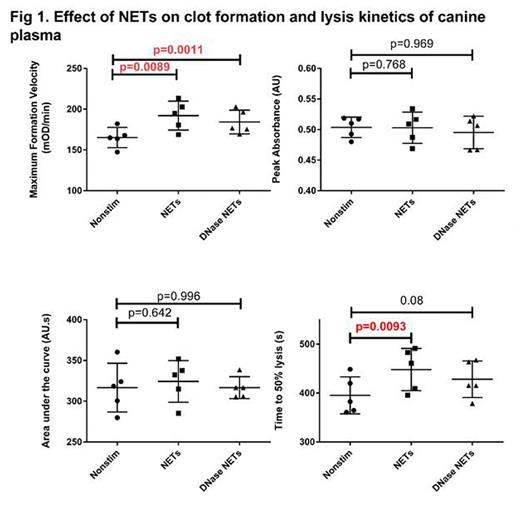Abstract
Pet dogs experience similar environmental influences to their owners, and thus provide valuable spontaneous models for investigation of novel therapies for human disease. DNase and treatments targeting neutrophil extracellular trap (NET) proteins show promise in murine thrombosis models. Dogs at risk of thrombosis could provide evidence for the efficacy of these treatments in a second species, but the pro-thrombotic effects of NETs on canine plasma must be confirmed.
We isolated neutrophils from healthy canine blood by density gradient and stimulated NET release using phorbol 12-myristate 13-acetate (PMA). To release NETs into suspension, culture media was replaced by the restriction enzyme Alu1. Supernatants were centrifuged to remove any intact cells. By gel electrophoresis, NET fragments were predominantly 600-1000 base pairs which is sufficient to simultaneously bind plasmin and fibrin (Arterioscler Thromb Vasc Biol., 2015, 35: 2544-53). To distinguish the effects of DNA and NET proteins, a subset of NET fragments were further digested with DNase. Supernatants were identically prepared from non-stimulated neutrophils. DNA concentration was 106ng/ml (sd 49, n=5 dogs) for non-stimulated supernatants; 401ng/ml (sd 94) for NET supernatants and reduced to 113ng/ml (sd 18) by DNase.
The effect of NETs on clot formation and lysis were measured spectrophotometrically. To bring fibrinogen into the range typically found in dogs suffering from pro-thrombotic disease, 4.2mg/ml of plasminogen-depleted fibrinogen was mixed with pooled platelet poor plasma from healthy dogs. Plasma was incubated with non-stimulated supernatants; NETs +/- DNase or controls for effects of restriction enzymes, PMA and culture media. We added tissue factor, 5mM calcium chloride and 100µg/ml tissue plasminogen activator and measured absorption at 405nm q. 10 seconds for 25 minutes.
NETs increased maximum formation velocity (MFV) (192mOD/min sd. 12, p=0.0011), measured by a line of best fit for the upswing of the curve, and delayed time to 50% clot lysis (448s sd. 43) compared with non-stimulated supernatants (165mOD/min sd. 12; 395s sd 38; n=5). Using a repeated measures ANOVA followed by paired t-tests with Tukey's correction, the effect on MFV (p=0.0089) but not time to 50% clot lysis (p=0.08) remained significant after DNase digestion. NETs did not have detectable effects on area under the curve (AUC) or peak (pANOVA >0.2) (Fig. 1). Reagent controls had no detectable effects on any parameter (pANOVA≥0.717; 5-6 technical replicates).
Reduction in fibrinolysis by DNA replicates its effect on human plasma (Arterioscler Thromb Vasc Biol., 2015, 35: 2544-53). The lack of effect of DNA on canine clot formation was surprising given the ability of DNA to increase human plasma thrombin generation (Arterioscler Thromb Vasc Biol. 2014, 34:1977-84). To determine if this was a species difference or a concentration dependent effect, DNA from canine leukocytes was added to plasma at a final concentration of 200ng/ml (approximately equal to the final concentration in our NET studies) or 1000ng/ml. At 1000ng/ml but not 200ng/ml, DNA increased MFV (p=0.038).
To determine if NET proteins were increasing MFV by a direct effect on fibrinogen or thrombin, we next studied effects of NETs on thrombin induced clotting of plasminogen-depleted fibrinogen. NETs with or without DNase digestion had no detectable effects on peak, AUC, MFV or fibrin fiber diameter estimated by turbidity. This suggests NET proteins increase plasma clot formation rate through interactions with coagulation components other than thrombin or fibrinogen. Based on human and murine studies showing NET proteins inhibit endogenous anticoagulants, we selected histones and elastase as candidate proteins for further investigation. Purified histones from calf thymus added to plasma at approximately the concentration present in NET supernatants (150ng/ml) had no effect on MFV. Pre-incubation of elastase with canine plasma abolished elastase activity measured by N-Succinyl-Ala-Ala-Ala-p-nitroanilide. Therefore, it is unlikely that the ability of canine NET proteins to increase MFV is mediated by elastase or histones alone.
In conclusion, NETs increase clot formation rate and delay lysis in canine platelet poor plasma. Since effects were mediated by both proteins and DNA, dogs are a promising model for trials of both DNase and therapies targeting NET proteins.
No relevant conflicts of interest to declare.
Author notes
Asterisk with author names denotes non-ASH members.


This feature is available to Subscribers Only
Sign In or Create an Account Close Modal